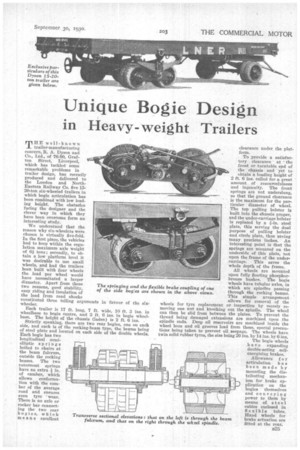Unique Bogie Design
Page 51

If you've noticed an error in this article please click here to report it so we can fix it.
in Heavy-weight Trailers
IMHE well-known trailer-manufacturing concern, R. A. Dyson and Co., Ltd., of 76-80, Grafton Street, Liverpool, which has tackled some remarkable problems in trailer design, has recently produced and delivered to the London and NorthEastern Railway Co. five 1520-ton six-wheeled trailers in which bogie articulation has been combined with low loading height. The obstacles facing the designer and the clever way in which they have been overcome form an interesting study.
We understand that the reason why six-wheelers were chosen is virtually five-fold. In the first place, the vehicles had to keep within the regulation maximum axle weight of 6i tons ; secondly, to obtain a low platform level it was desirable to use small wheels, and had the trailers been built with four wheels the load per wheel would have necessitated a larger diameter. Apart from these two reasons, good stability, easy riding and insulation of the load from road shocks constituted three telling arguments wheeler.
Each trailer is 17 ft. long, 7 ft. wide, 10 ft. 3 ins. in wheelbase to bogie centre, and 2 ft. 6 ins, in bogie wheelbase. The height of the chassis (laden) is 2 ft. 6 ins. clearance under the platform.
To _provide a satisfac tory clearance at ' the front or turntable end of the chassis and yet to obtain a loading height of 2 ft 6 ins, called for a great amount of resourcefulness and ingenuity. The front springs are not nnderslung, so that the ground clearance is the maximum for the particular diameter of wheel. The top pulling bolster is built into the chassis proper, and the under-carriage bolster is replaced by a fin, steel plate, this serving the dual purpose of pulling bolster and circle plate, thus saving many precious inches. An interesting point is that the springs are mounted on the underside of this plate, not upon the frame of the undercarriage. This saves the whole depth of the frame.
All wheels are mounted upon fully floating phosphorbronze bushes. The bogie wheels have tubular axles, in which are spindles passing through the rocking beams. This simple arrangement allows for removal of the wheels for tyre replacement or inspection by merely removing one nut and knocking out the spindle. The wheel can then be slid from between the plates. To prevent the thread being damaged extensions are machined upon ,the spindle ends. Deep oil reservoirs are machined inside the wheel bore and oil grooves lead from these, special precautiOrla being taken to prevent oil seepage. The wheels have twin solid rubber tyres, the size being 20 ins. by 14 ins. by 6 ins.
The bogie wheels have expanding double-acting selfenergizing brakes.
Allowance f o r articulation h a s been made by mounting the distributing mechanism for brake application on the bogies themselves and conveying power to them by means of steel cables enclosed in flexible tubes. Hand wheels for brake actuation are fitted at the rear.




















































































































